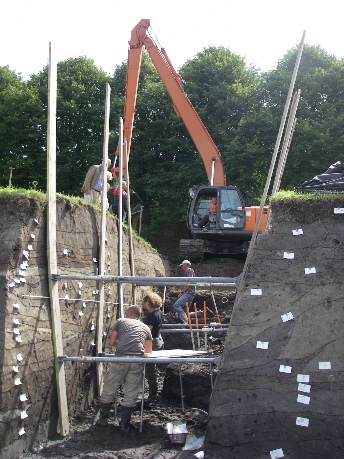Book on the archaeological treasure troves of Friesland
On Thursday 11 Ma y the book Friese terpen in doorsnede: Landschap, bewoning en exploitatie [Cross-sections of Frisian terps: Landscape, settlements, and development] will be released. The book was written by Dr John Nicolay , archaeologist at the University of Groningen, and Prof. Gilles de Langen , Professor by special appointment of the Frisian Coastal Area at the University of Groningen, who also works for the Province of Fryslân. The book is the result of six years of archaeological research and tells the fascinating history of the area based on an archaeological cross-section of six Frisian artificial dwelling mounds, known as ‘terps’. It pays special attention to the extraordinary dynamics between those living on the terps and the salt marshes they inhabited.
Text: Marjolein te Winkel
The book details the results of archaeological research which was conducted between 2006 and 2012 on the terps of Anjum, Achlum, Jelsum, Firdgum, Oosterbeintum, and Dronrijp. The excavations attracted a lot of attention, and were partly conducted by an enthusiastic core group of volunteers.
Archaeological treasure troves
Terps are the archaeological treasure troves of Friesland and provide a unique glimpse into the rich history of the area, starting from the time the first colonists settled on the uncovered marsh lands about 2,500 years ago. These mounds were erected so people could safely live on them, and by subsequently raising them little by little by adding clay and waste, hundreds of terps and ‘wierden’ (as they are commonly called in Groningen) arose, which still characterize the landscape of Friesland and Groningen.

Steep side research
On the six Frisian terps, ‘steep side’ research was carried out, in which a long cross-section (the ‘steep side’) was made of the terp. This would reveal the layers making up the terp, and meant that a number of finds could be collected. These layers each tell a part of the habitation history, which traces back to a number of centuries before the start of the Common Era. The book tells the rich history of the six terps, and pays special attention to the relationship between humans and the landscape at a time when people did not fight the water, but lived in harmony with it.
The research project was a collaboration between the Province of Fryslân and the Groningen Institute of Archaeology of the University of Groningen. The book was compiled and partly written by Johan Nicolay (UG) and Gilles de Langen (UG/Province of Fryslân).
More news
-
16 December 2025
How AI can help people with language impairments find their speech
-
18 November 2025
What about the wife beater? How language reinforces harmful ideas
-
03 November 2025
Menopause in perspective: How the media influences our perception
